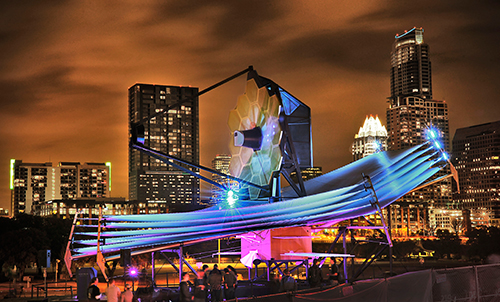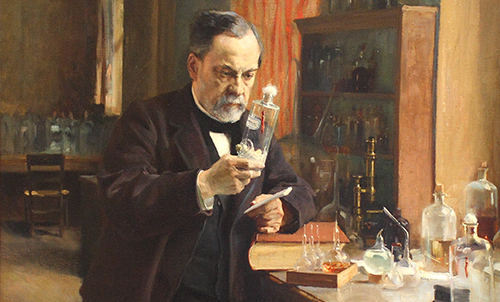
(Collage by Joy Olivia Miller)
Astronomers and planetary scientists debate if and when we’ll find extraterrestrial life.
The event: an Oxford-style debate. The occasion: a celebration of the Department of Astronomy and Astrophysics’s 123rd year, in conjunction with the University of Chicago’s 125th anniversary last fall. The place: the William Eckhardt Research Center, the department’s new home. The proposition: by the end of 2042—significant for being 150 years after the department’s founding—remote sensing will reveal evidence of extant life on an exoplanet. The fine print: we don’t have to physically visit the site; evidence does not mean certain proof; organisms must be currently living; and life forms need not be intelligent. The winner: to be determined by audience vote.
Pro: We are not alone Con: We are alone—or might as well be • Life finds a way • Pasteur’s proof • Little not-so-green men • Spacefarers • Big glass • Green paper A brief rebuttal The verdict
The finer print: the debate deals with life as we know it; alien life could be so alien we might not even recognize it.
Pro: We are not alone
Life finds a way
Dorian Abbot, Associate Professor of Geophysical Sciences Abbot launched the arguments for why we would find life with five points supporting the claim that life is common, particularly microbial life.

Kepler-11 is a small, cool star around which six planets orbit. (Artist rendition courtesy NASA/Tim Pyle)
- Earth-like terrestrial planets are plentiful in the universe, as revealed by the Kepler mission, offering ample opportunity for habitable environments.
- “The raw materials for life are everywhere,” said Abbot. Hydrogen, oxygen, carbon—they can be found on asteroids, moons, other planets, and in interstellar space.
- As far as scientists can tell, life arose on Earth about as soon as it could have. Earth is 4.5 billion years old, and the earliest geochemical evidence of life appeared 4.1 billion years ago. “If you get those conditions elsewhere, you’re probably going to get simple life.”
- Life thrives on Earth in extreme conditions, like in hot springs and deep-sea vents and Antarctica.
- Life is resilient. “Once it arises, it’s hard to get rid of,” said Abbot. Asteroid impacts, hothouse climates, and “snowball Earth” events that froze the entire planet—despite mass extinctions, microbial life has persisted.
Little not-so-green men
Leslie Rogers, Assistant Professor of Astronomy and Astrophysics Rogers discussed how we would detect life through observation and measurement of biosignature gases. “Even simple life will modify its environment,” said Rogers. “No matter how ‘green’ these aliens are, they will inevitably pollute.” The question is whether that pollution will be detectable and distinguishable as a biosignature rather than from an abiotic process, like volcanic activity. The key will be finding an ideal biosignature gas to look for. Water, methane, and carbon dioxide all arise from geophysical processes. Astronomers must find a molecule that doesn’t exist naturally in a planet’s atmosphere, is not created by planetary processes, is not produced or destroyed quickly by interaction with light, and has a strong enough spectral signature to be detected from a great distance. If an alien species were looking for an ideal biosignature from Earth, O2 or ammonia would fit the bill.
Big glass
Laura Kreidberg, SM’13, PhD’16, NSF Graduate Research Fellow in Astronomy and Astrophysics (now at Harvard) Kreidberg addressed technology: “The million dollar question is, will we actually be able to detect these biosignatures by 2042? Actually perhaps more likely the 10 billion dollar question.” She explained the main technique used to analyze atmospheres, called transmission spectroscopy. When a planet passes in front of its star from our perspective, molecules in its atmosphere absorb light, producing an observable spectrum, from which astronomers can infer the planet’s atmospheric composition and temperature.

The full-scale James Webb Space Telescope model at South by Southwest in Austin. (Photo courtesy NASA/Chris Gunn)
To detect biosignatures reliably, they’ll need more precise measurements, which the James Webb Space Telescope will collect when it launches in 2018. To achieve direct imaging, astronomers need an even more powerful telescope, such as the 12-meter ultraviolet-optical-infrared observatory proposed by the Associated Universities for Research in Astronomy for development in the 2030s. “Then,” said Kreidberg, “we’d be in business.”
Con: We are alone—or might as well be
Pasteur’s proof
Edwin Kite, Assistant Professor of Geophysical Sciences To kick off the arguments that we won’t find evidence of life, Kite considered the likelihood of life arising from chemical reactions. “We all hope that life is widespread in the universe; anything else would seem like a waste of space,” said Kite. “But we should vote based on facts, not hopes, and the facts are that the origin of life appears to be very difficult.” Scientists have known since Pasteur’s 1859 experiment that spontaneous generation doesn’t exist, and all efforts to coax life from its necessary components in a laboratory have failed. Nearby planets and moons have had all the prerequisites for life in just the right conditions for millions of years, and still no life has arisen.

Edelfelt, Albert. Louis Pasteur. 1885. Oil on canvas. Musée D'Orsay, Paris.
The rise of life isn’t impossible, Kite noted, because it obviously has happened at least once in the universe. So he laid out two scenarios: life is easy and common (which seems unlikely considering our failed experiments at creating life and nearby observation) or life is rare, spread out across swaths of lifeless space too vast to overcome any time soon. He insisted that the audience shouldn’t feel any cognitive dissonance in voting no. They can still support exoplanet research while acknowledging that it’s unlikely to find alien life by 2042.
Spacefarers
Daniel Fabrycky, Assistant Professor of Astronomy and Astrophysics Fabrycky’s discussion on whether we’ll find simple life centered on whether we might find—or be found by—intelligent life. He conjured Fermi’s paradox, often mentioned when discussing alien life. Put simply (and perhaps incorrectly): If aliens are out there, where is everybody? Why are we not in contact now, and if they’ve visited, why are there no artifacts? “In this audience, I don't think I have to defend that proposition—that there are no such artifacts,” said Fabrycky. “Not even a measly obelisk on the moon.” Fabrycky pointed out that our solar system has traveled around the galaxy 50 times since it formed, with only the help of gravity. “If you have rockets and intelligence propelling you, you can get around the galaxy much quicker.” If aliens were coming, they should be here by now. For contact to be made, a series of states must be achieved, according to the Drake equation.
- There must be terrestrial planets older than Earth.
- Nonliving molecules must form into living, replicating organisms.
- Life must evolve from simple organisms to complex, intelligent life.
- Intelligent life must develop technology advanced enough to populate the galaxy.
Robin Hanson, AM’84, SM’84, a physics-trained economist, proposed the “great filter” argument, Fabrycky noted, that somewhere in that series of states exists an insurmountable obstacle, which is why our galaxy isn’t swarming with alien life. But at which stage is the filter? Kepler has found numerous suitable exoplanets as well as star systems far older than our own, so no problem there. Once step two is passed, where raw materials become life, there would be biosignatures, and the debate’s proposition could be true. Fabrycky thinks this is the filter. Humans are in step three, having evolved into intelligent beings via a process well understood and documented (and thus not likely the filter). So, in Fabrycky’s argument, the filter is either the origin of life or our capacity for interstellar travel. If you believe that we will find evidence of simple life, then you believe that the filter is ahead of us, that neither we nor any other intelligent species will ever leave our solar system. “By voting YES on your post-debate slip, you are dooming humanity. To vote YES to the future of humanity, you must vote NO to biosignatures.”
Green paper
Jacob Bean, Assistant Professor of Astronomy and Astrophysics Closing out the con side, Bean reiterated that any search for life would face technological, scientific, and procedural challenges. But the greatest challenges will be ideological and economic—getting exoplanet researchers to agree on the right strategy and then convincing the broader astronomical community, the public, and the government to buy in. “Science aside, technology aside, my pessimism about human nature suggests that we are not going to pull that off by 2042, that it’s going to be the money that limits us, not the ability to do the observations or to interpret the measurements.”
A brief rebuttal
Abbot rebutted Kite’s rare life claim, suggesting that life could have arisen multiple times on Earth but been out-competed by a more dominant form. He also suggested that Fabrycky overestimated the ease of evolution, noting it took three billion years to get to our current state. “Intelligent life doesn’t seem Darwinianly favorable. Cows are doing just fine not building radio telescopes.” Kreidberg pushed back on Bean—who happens to be her adviser and who convinced her to pursue exoplanet research—saying that he discounts tremendous public fascination with the search for alien life and human ingenuity to develop cheaper methods for exploration. Kite rebutted the use of certain gases as biomarkers: “Oxygen sucks.” When light breaks down water, hydrogen escapes into space easily, leaving oxygen to build up, increasing the chance of a false positive. Bean admitted that he “actually should be sitting on the other side.” His argument was more of a challenge to get people on board and “make this happen.”
The verdict
Before the debate, the audience voted 38 for yes, we will find life; and 33 for no, we’re on our own. Afterwards, 38 for yes, 40 for no. Astronomy and Astrophysics chair Angela Olinto joked, “I think we are following the Chicago tradition of voting often,” before declaring a tie.
Before appearing in the Fall/16 issue of Inquiry, this story was originally published online May 9, 2016.
